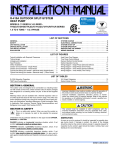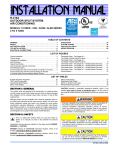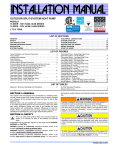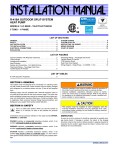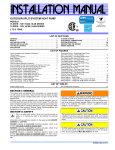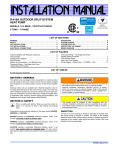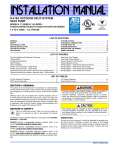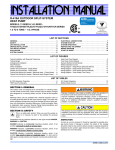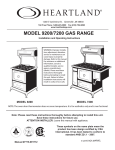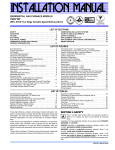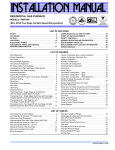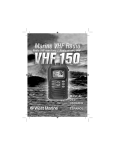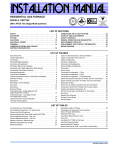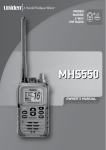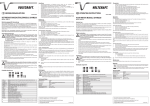Download York YHJF060 Installation manual
Transcript
INSTALLATION MANUAL R-410A OUTDOOR SPLIT-SYSTEM HEAT PUMP ® MODELS: 14.5 SEER - YHJF60/THJF60 5 TONS – 1 PHASE LIST OF SECTIONS GENERAL . . . . . . . . . . . . . . . . . . . . . . . . . . . . . . . . . . . . . . . . . . . . . .1 SAFETY . . . . . . . . . . . . . . . . . . . . . . . . . . . . . . . . . . . . . . . . . . . . . . . .1 UNIT INSTALLATION . . . . . . . . . . . . . . . . . . . . . . . . . . . . . . . . . . . . .2 INDOOR EXPANSION DEVICE . . . . . . . . . . . . . . . . . . . . . . . . . . . . . .5 EVACUATION . . . . . . . . . . . . . . . . . . . . . . . . . . . . . . . . . . . . . . . . . . .6 SYSTEM CHARGE . . . . . . . . . . . . . . . . . . . . . . . . . . . . . . . . . . . . . . .6 ELECTRICAL CONNECTIONS . . . . . . . . . . . . . . . . . . . . . . . . . . . . . 7 SYSTEM START-UP . . . . . . . . . . . . . . . . . . . . . . . . . . . . . . . . . . . . . 8 SYSTEM OPERATION . . . . . . . . . . . . . . . . . . . . . . . . . . . . . . . . . . . 11 INSTRUCTING THE OWNER . . . . . . . . . . . . . . . . . . . . . . . . . . . . . 11 WIRING DIAGRAM . . . . . . . . . . . . . . . . . . . . . . . . . . . . . . . . . . . . . 12 START UP SHEET . . . . . . . . . . . . . . . . . . . . . . . . . . . . . . . . . . . . . . 13 LIST OF FIGURES Typical Installation with Required Clearances . . . . . . . . . . . . . . . . . . .2 Tubing Hanger . . . . . . . . . . . . . . . . . . . . . . . . . . . . . . . . . . . . . . . . . . .3 Underground Installation . . . . . . . . . . . . . . . . . . . . . . . . . . . . . . . . . . .4 Heat Protection . . . . . . . . . . . . . . . . . . . . . . . . . . . . . . . . . . . . . . . . . .4 Outdoor Unit Control Box - 14.5 SEER 60 Only . . . . . . . . . . . . . . . . . .7 Thermostat Wiring – Two-Stage Heat Pump Variable Speed Air Handler . . . . . . . . . . . . . . . . . . . . . . . . . . . . . . . . .8 Thermostat Wiring – Two-Stage Heat Pump Variable Speed Air Handler . . . . . . . . . . . . . . . . . . . . . . . . . . . . . . . . 9 CFM Selection Board . . . . . . . . . . . . . . . . . . . . . . . . . . . . . . . . . . . . 10 Heat Pump Flow Diagram . . . . . . . . . . . . . . . . . . . . . . . . . . . . . . . . . 11 Wiring Diagram - Single Phase - 14.5 SEER - 5 Ton . . . . . . . . . . . . 12 LIST OF TABLES Maximum / Minimum Operating Limit Conditions . . . . . . . . . . . . . . . . .2 SECTION I: GENERAL The outdoor units are designed to be connected to a matching indoor coil with sweat connect lines. Sweat connect units are factory charged with refrigerant for the smallest rated indoor coil plus 15 feet of field supplied lines. Matching indoor coils require a matching thermostatic expansion valve (TXV) - refer to the Tabular Data Sheet or Technical Guide. The refrigerant charge may need to be changed for some indoor-outdoor unit combinations, elevation differences, or total line lengths. Refer to Application Data covering “General Piping Recommendations and Refrigerant Line Length” (Part Number 247077). SECTION II: SAFETY This is a safety alert symbol. When you see this symbol on labels or in manuals, be alert to the potential for personal injury. Understand and pay particular attention to the signal words DANGER, WARNING, or CAUTION. R-410A Saturation Properties . . . . . . . . . . . . . . . . . . . . . . . . . . . . . . . 7 CAUTION indicates a potentially hazardous situation, which, if not avoided may result in minor or moderate injury. It is also used to alert against unsafe practices and hazards involving only property damage. Improper installation may create a condition where the operation of the product could cause personal injury or property damage. Improper installation, adjustment, alteration, service, or maintenance can cause injury or property damage. Refer to this manual for assistance or for additional information, consult a qualified contractor, installer, or service agency. This product must be installed in strict compliance with the enclosed installation instructions and any applicable local, state, and national codes including, but not limited to building, electrical, and mechanical codes. DANGER indicates an imminently hazardous situation, which, if not avoided, will result in death or serious injury. WARNING indicates a potentially hazardous situation, which, if not avoided, could result in death or serious injury. R-410A systems operate at higher pressures than R-22 systems. Do not use R-22 service equipment or components on R-410A equipment. Service equipment Must Be Rated for R-410A. 835959-UIM-D-0814 835959-UIM-D-0814 INSPECTION SECTION III: UNIT INSTALLATION As soon as a unit is received, it should be inspected for possible damage during transit. If damage is evident, the extent of the damage should be noted on the carrier’s delivery receipt. A separate request for inspection by the carrier’s agent should be made in writing. Local Distributor can be contacted for more information. LOCATION Requirements For Installing/Servicing R-410A Equipment • Gauge sets, hoses, refrigerant containers, and recovery system must be designed to handle the POE type oils, and the higher pressures of R-410A. Manifold sets should be 800 psig high side and 250 psig low side with 550 psig low side restart. All hoses must have a 700 psig service pressure rating. Leak detectors should be designed to detect HFC refrigerant. Recovery equipment (including refrigerant recovery containers) must be specifically designed to handle R-410A. Do not use an R-22 TXV. A liquid-line filter drier is required on every unit. • • • • • • LIMITATIONS The unit should be installed in accordance with all National, State, and Local Safety Codes and the limitations listed below: 1. Limitations for the indoor unit, coil, and appropriate accessories must also be observed. The outdoor unit must not be installed with any duct work in the air stream. The outdoor fan is the propeller type and is not designed to operate against any additional external static pressure. The maximum and minimum conditions for operation must be observed to assure a system that will give maximum performance with minimum service. Refer to the dry bulb (DB) and wet bulb (WB) temperature limitations in Table 1. The 2 stage units are not designed to operate with a low ambient kit. The 2 stage models which can not operate with a low ambient kit include YHJF and THJF models. Do not modify the control system of these models to operate with any kind of low ambient kit. The maximum allowable line length for this product is 75 feet 2. 3. 4. 5. . TABLE 1: Maximum / Minimum Operating Limit Conditions AIR TEMPERATURE AT OUTDOOR COIL, °F Min. AIR TEMPERATURE AT INDOOR COIL, °F Max. Min. Max. DB Cool DB Heat DB Cool DB Heat WB Cool DB Heat WB Cool DB Heat 50 -10 115 75 57 501 72 80 1. Operation below this temperature is permissible for a short period of time, during morning warm-up. 1. 60” OVERHEAD CLEARANCE Before starting the installation, the suitability of the location for both the indoor and outdoor units need to be checked. All required limitations and clearances must be observed. The outdoor unit must have sufficient clearance for air entrance to the condenser coil, for air discharge, and for service access as shown in Figure 1. NOTICE For multiple unit installations, units must be spaced a minimum of 24 inches apart (coil face to coil face). If the unit is to be installed on a hot sun exposed roof or a paved ground area that is seasonally hot, the unit should be raised sufficiently above the roof or ground to avoid taking the accumulated layer of hot air into the outdoor unit. Provide adequate structural support. ADD-ON REPLACEMENT/RETROFIT When this unit is being used as a replacement for an R-22 unit, it is required that the outdoor unit, indoor coil, and metering device all be replaced. The following steps should be performed in order to insure proper system operation and performance. Line-set change out is also recommended. 1. Change-out of the indoor coil to an approved R-410A coil/ condensing unit combination with the appropriate metering device. 2. Change-out of the line-set when replacing an R-22 unit with an R410-A unit is highly recommended to reduce cross-contamination of oils and refrigerants. 3. If change-out of the line set is not practical, then the following precautions should be taken. • Inspect the line set for kinks, sharp bends, or other restrictions, and for corrosion. • Determine if there are any low spots which might be serving as oil traps. • Flush the line set with a commercially available flush kit to remove as much of the existing oil and contaminants as possible. • Install a suction line filter-drier to trap any remaining contaminants, and remove after 50 hours of operation. 4. If the outdoor unit is being replaced due to a compressor burnout, then installation of a 100% activated alumina suction-line filter drier in the suction-line is required, in addition to the factory installed liquid-line drier. Operate the system for 10 hours. Monitor the suction drier pressure drop. If the pressure drop exceeds 3 psig, replace both the suction-line and liquid-line driers. After a total of 10 hours run time where the suction-line pressure drop has not exceeded 3 psig, replace the liquid line drier, and remove the suction-line drier. During the contamination removal procedure, never leave a suctionline drier in the system longer than 50 hours of run time. MINIMUM 18” SERVICE ACCESS CLEARANCE ON ONE SIDE THERMOSTAT WEATHERPROOF DISCONNECT SWITCH NEC CLASS 1 WIRING NEC CLASS 2 WIRING 10” CLEARANCE AROUND PERIMETER TO FURNACE OR AIR HANDLER TERMINAL BLOCK TO INDOOR COIL NOTES: ALL OUTDOOR WIRING MUST BE WEATHERPROOF. MINIMUM 24” UNIT TO UNIT CLEARANCE. CONTROL ACCESS PANEL SEAL OPENING(S) WITH PERMAGUM OR EQUIVALENT A0167-001 FIGURE 1: Typical Installation with Required Clearances 2 Johnson Controls Unitary Products 835959-UIM-D-0814 GROUND INSTALLATION The unit may be installed at ground level on a solid base that will not shift or settle, causing strain on the refrigerant lines and possible leaks. The unit must be installed in as level a position as possible while maintaining the clearances shown in Figure 1. Normal operating sound levels may be objectionable if the unit is placed directly under windows of certain rooms (bedrooms, study, etc.). Condensate will drain from beneath the coil of the outdoor unit during the defrost cycle. Normally this condensate may be allowed to drain directly on the ground. The outdoor unit should not be installed in an area where mud or ice could cause personal injury. Remember that condensate will drip from the unit coil during heat and defrost cycles and that this condensate will freeze when the temperature of the outdoor air is below 32°F. Elevate the unit sufficiently to prevent any blockage of the air entrances by snow in areas where there will be snow accumulation. Check the local weather bureau for the expected snow accumulation in your area. Isolate the unit from rain gutters to avoid any possible wash out of the foundation. ROOF INSTALLATION When installing units on a roof, the structure must be capable of supporting the total weight of the unit, including a pad, lintels, rails, etc., which should be used to minimize the transmission of sound or vibration into the conditioned space. WALL MOUNT INSTALLATION Care must be taken to mount the outdoor unit on a solid base that is sloped to shed water, secure from settlement, and is isolated from the structural foundation or walls to prevent sound and vibration transmission into the living space. In addition heat pump units must be elevated above anticipated snow accumulation levels to allow for proper defrost drainage and airflow. On occasion, site conditions may require direct wall mounted brackets to be used to locate and support the outdoor unit. In these applications, care must be taken to address unit base pan support, structural integrity, safe access and serviceability, as well as the possible sound and vibration transmission into the structure. These applications are best served by a properly engineered solution. UNIT PLACEMENT NOTICE Heat pumps will defrost periodically resulting in water drainage. The unit should not be located where water drainage may freeze and create a hazardous condition - such as sidewalks and steps. 1. 2. 3. 4. Provide a base in the pre-determined location. Remove the shipping carton and inspect for possible damage. Ensure that compressor tie-down bolts remain tightened. Position the unit on the base provided. LIQUID LINE FILTER-DRIER NOTICE Replacements for the liquid line drier must be exactly the same as marked on the original factory drier. See Source 1 for O.E.M. replacement driers. R-410A Filter-Drier Source 1 Part No. Apply with Models S1-404101 All PIPING CONNECTIONS Never install a suction-line filter drier in the liquid line of an R-410A system. Failure to follow this warning can cause a fire, injury or death. This system uses R-410A refrigerant only, which operates at higher pressures than R-22. No other refrigerant than R-410A may be used in this system. Gauge sets, hoses, refrigerant containers, and recovery system must be designed to handle R-410A. If you are unsure, consult the equipment manufacturer. The outdoor unit must be connected to the indoor coil using field supplied refrigerant grade copper tubing that is internally clean and dry. Units should be installed only with the tubing sizes for approved system combinations as specified in Tabular Data Sheet. The charge given is applicable for total tubing lengths up to 15 feet. See Application Data Part Number 247077 for installing tubing of longer lengths and elevation differences. NOTICE Using a larger than specified line size could result in oil return problems. Using too small a line will result in loss of capacity and other problems caused by insufficient refrigerant flow. Slope horizontal vapor lines at least 1" every 20 feet toward the outdoor unit to facilitate proper oil return. PRECAUTIONS DURING LINE INSTALLATION 1. Install the lines with as few bends as possible. Make sure there is no damage done to the couplings or kink made in the tubing. Use clean hard drawn copper tubing where no appreciable amount of bending around obstruction is necessary. If soft copper must be used, make sure to avoid sharp bends which may cause a restriction. 2. Ensure that the lines are installed so they do not obstruct service access to the coil, air handling system, or filter. 3. Make sure to isolate the refrigerant lines to minimize noise transmission from the equipment to the structure. 4. Make sure to insulate the vapor line with a minimum of 1/2” foam rubber insulation (Armaflex or equivalent). Make sure to insulate the liquid lines which are exposed to direct sunlight and/or high temperatures. 5. Tape and suspend the refrigerant lines as shown in Figure 2. DO NOT allow tube metal-to-metal contact. SHEET METAL HANGER The heat pumps have a solid core bi-flow filter/drier located on the liquid line. LIQUID LINE INCORRECT Failure to use the same as the original factory drier or using a substitute drier or a granular type may result in damage to the equipment. CORRECT TAPE INSULATED VAPOR LINE A0151-001 FIGURE 2: Tubing Hanger Johnson Controls Unitary Products 3 835959-UIM-D-0814 6. Use PVC piping as a conduit for all underground installations as shown in Figure 3. Keep buried lines as short as possible to minimize the build up of liquid refrigerant in the vapor line during long periods of shutdown. 7. Pack fiberglass insulation and a sealing material such as permagum around refrigerant lines where they penetrate a wall to reduce vibration and to retain some flexibility. 8. See Application Data Part Number 247077 for additional piping information. LIQUID LINE PVC CONDUIT TO INDOOR COIL TO OUTDOOR UNIT INSULATED VAPOR LINE CAP A0153-001 FIGURE 4: Heat Protection Connect the refrigerant lines using the following procedure: A0152-001 FIGURE 3: Underground Installation PRECAUTIONS DURING BRAZING OF LINES All outdoor unit and evaporator coil connections are copper-to-copper and should be brazed with a phosphorous-copper alloy material such as Silfos-5 or equivalent. DO NOT use soft solder. The outdoor units have reusable service valves on both the liquid and vapor connections. The total system refrigerant charge is retained within the outdoor unit during shipping and installation. The reusable service valves are provided to evacuate and charge per this instruction. Serious service problems can be avoided by taking adequate precautions to assure an internally clean and dry system. Dry nitrogen should always be supplied through the tubing while it is being brazed, because the temperature required is high enough to cause oxidation of the copper unless an inert atmosphere is provided. The flow of dry nitrogen should continue until the joint has cooled. Always use a pressure regulator and safety valve to insure that only low pressure dry nitrogen is introduced into the tubing. Only a small flow is necessary to displace air and prevent oxidation. PRECAUTIONS DURING BRAZING SERVICE VALVE Precautions should be taken to prevent heat damage to service valve by wrapping a wet rag around it as shown in Figure 4. Also, all painted surfaces, insulation, and the plastic base should be protected during brazing. After brazing, joint should be cooled with wet rag. This is not a backseating valve. The service access port has a valve core. Opening or closing valve does not close service access port. If the valve stem is backed out past the chamfered retaining wall, the O-ring can be damaged causing leakage or system pressure could force the valve stem out of the valve body possibly causing personal injury. Valve can be opened by removing the plunger cap and fully inserting a hex wrench into the stem and backing out counter-clockwise until valve stem just touches the chamfered retaining wall. 1. Remove the cap and Schrader core from both the liquid and vapor valve service ports at the outdoor unit. Connect low pressure nitrogen to the liquid line service port. 2. Braze the liquid line to the liquid valve at the outdoor unit. Be sure to wrap the valve body with a wet rag. Allow the nitrogen to continue flowing. Refer to the Tabular Data Sheet for proper liquid line sizing. 3. Go to SECTION IV, and accomplish the TXV Installation procedure. Do not install any coil in a furnace which is to be operated during the heating season without attaching the refrigerant lines to the coil. The coil is under 30 to 35 psig inert gas pressure which must be released to prevent excessive pressure build-up and possible coil damage. 4. Braze the liquid line to the evaporator liquid connection. Ensure that nitrogen is flowing through the evaporator coil to prevent oxidation during brazing procedure. 5. Remove the split rubber grommet from the vapor connection at the indoor coil. Braze the vapor line to the evaporator vapor connection. After the connection has cooled, place the rubber grommet back into the mounting position. Refer to the Tabular Data Sheet for proper vapor line sizing. 6. Protect the vapor valve with a wet rag, and braze the vapor line connection to the outdoor unit. Ensure that the nitrogen flow is exiting the system from the vapor service port connection. After this connection has cooled, remove the nitrogen source from the liquid fitting service port. 7. Replace the Schrader core in the liquid and vapor valves. Never attempt to repair any brazed connections while the system is under pressure. Personal injury could result. NOTICE Refrigeration piping and indoor coil can be pressurized to 250 psig with dry nitrogen and leak tested with a bubble type leak detector. Then release the nitrogen charge. Do not use the system refrigerant from the outdoor unit to purge or leak test the system. 8. Leak test and repair leaks in all refrigerant piping connections including the service port flare caps. DO NOT OVERTIGHTEN caps. Torque caps between 40 and 60 inch - lbs. maximum. 9. Evacuate the vapor line, the evaporator, and the liquid line to 500 microns or less in accordance with the EVACUTATION procedures. 4 Johnson Controls Unitary Products 835959-UIM-D-0814 Do not connect manifold gauges unless trouble is suspected. Approximately 3/4 ounce of refrigerant will be lost each time a standard manifold gauge is connected. 10.Release the refrigerant charge into the system in accordance with the SYSTEM CHARGE procedures. Open the liquid line base valve first and let pressures equalize. Then, open the suction line base valve. When opening either valve, use an appropriate hex head wrench and back seat the base valve by turning it counter clockwise until it stops against the chamfered retaining wall, and then turn it back 1/8 turn. If the service valve is a ball valve, use an adjustable end wrench to turn valve stem one-quarter turn counterclockwise to open. Do not overturn (or the valve stem may break or become damaged). 11.To prevent leaks, replace base valve caps finger tight, and then tighten the cap an additional 1/12 turn (1/2 hex flat). 12.Replace cap on service ports. Do not remove the flare caps from the service ports except when necessary for servicing the system. 13. See “System Charge” section for checking and recording system charge. 3. Before the suction line from the outdoor unit is brazed to the indoor coil suction line, remove and discard black plastic cap from equalizer fitting on the indoor coil suction line. 4. Loosen and remove distributor cap seal. NOTICE Do not install TXV onto distributor assembly until field supplied liquid line is brazed onto the indoor coil liquid line and cooled. 5. Install the TXV to the distributor assembly by hand tightening, and then turn fitting an additional 1/4 turn to seal. Do not overtighten fittings. Do not use slip joint pliers. Damage and distortion of distributor can prevent proper seal. Use appropriate sized adjustable end wrench. 6. Install the liquid line to the top of the TXV using the liquid line fitting which is supplied with the indoor coil. Hand modify the liquid line to align with casing opening. Hand tighten the liquid line on the TXV, and tighten an additional 1/4 turn to seal. SECTION IV: INDOOR EXPANSION DEVICE THERMOSTATIC EXPANSION VALVE (TXV) INSTALLATION Before accomplishing the following procedures, verify the proper TXV kit to be installed on the coil. Refer to supplied Tabular Data Sheet for specific TXV kit and indoor coil match up. The following are basic steps for installation of a TXV kit. For detailed instructions, refer to the Installation Instructions accompanying the TXV kit. A schrader valve core MUST NOT be installed in the equalizer fitting when the TXV kit is installed. Poor system performance or system failure could result. NOTICE Do not install TXV equalizer line onto equalizer fitting nor the TVX bulb onto the suction vapor line until field supplied suction line is brazed onto the indoor coil suction line and cooled. Install TXV kit as follows: 1. Relieve nitrogen holding charge by depressing the Schrader valve stem located in the end of the suction line. After nitrogen holding charge is completely discharged, cut off the spundown copper end of the suction line to allow installation of the field supplied suction line. In all cases, do not mount the TXV bulb until after the suction line is brazed and has had sufficient time to cool. Dry nitrogen should always be supplied through the tubing while it is being brazed, because the temperature is high enough to cause oxidation of the copper unless an inert atmosphere is provided. The flow of dry nitrogen should continue until the joint has cooled. Always use a pressure regulator and safety valve to insure that only low pressure dry nitrogen is introduced into the tubing. Only a small flow is necessary to displace air and prevent oxidation. 7. Install the TXV equalizer line onto the equalizer fitting of the suction line. Hand tighten the 1/4” SAE nut to the equalizer fitting, and tighten an additional 1/3 turn to seal. NOTICE The TXV bulb is to be installed on the suction line near the equalizer line, using the two bulb clamps furnished with the TXV assembly kit. The bulb is to make maximum contact. The TXV installation instruction provide an illustration of proper bulb location. 8. Install the TXV bulb to the suction line near the equalizer line, using the bulb clamp(s) furnished with the TXV assembly kit. Ensure the bulb is making maximum contact. a. Install the bulb on the suction line near the equalizer line with the bulb horizontal to the suction line. On a suction line under 7/8” Outside Diameter (O.D.), install the bulb on top of the line. On a suction line 7/8” O.D. or larger, install the bulb at about the 2 or 10 o'clock position. b. If bulb must be installed vertically to the suction line, position the bulb at least 16 inches (40.6 cm) from any bend and on the opposite side of the bend plane. Positioned the bulb with the bulb tail at the top, so that the bulb acts as a reservoir. c. Use thermal insulation provided to protect the bulb from the effect of the surrounding ambient temperature. Cover the bulb completely to insulate from air-stream. 2. Slide indoor coil out of cabinet far enough to gain access to equalizer fitting on the suction line. NOTICE All connections to be brazed are copper-to-copper and should be brazed with a phosphorous-copper alloy material such as Silfos-5 or equivalent. Soft solder is NOT to be used. Johnson Controls Unitary Products 9. Slide indoor coil back into cabinet. 10.Leak test system after outdoor unit is connected. 5 835959-UIM-D-0814 SECTION V: EVACUATION During this process, it is necessary to evacuate the system to 500 microns or less. If a leak is suspected, a dry nitrogen charge is used to locate leak(s). After repairing any leaks, another leak test is to be performed. To verify that the system has no leaks, the system is held under a vacuum by closing the valve to the vacuum pump suction isolating the pump. The micron gauge is observed for a few minutes. If the micron gauge indicates a steady and continuous rise, it is an indication of a leak. If the gauge shows a rise, then levels off after a few minutes and remains fairly constant above 500 microns, it is an indication that the system is leak free but still contains moisture and may require further evacuation. Proper system evacuation requires the micron gauge to indicate a vacuum holding below 500 microns for several minutes. SECTION VI: SYSTEM CHARGE Refrigerant charging should only be carried out by a qualified air conditioning contractor. To ensure that your unit performs at the published levels, it is important that the indoor airflow is determined and refrigerant charge added accordingly. MEASURE INDOOR AIR FLOW To determine rated air flow for a specific match, consult the technical literature at www.upgnet.com. When attempting to match this air flow, select the lowest possible speed tap, measure the actual flow, and adjust as necessary. To measure actual air flow, it is not an acceptable method to just check the jumper pin setting tables and to assume 0.5” static pressure drop. To determine indoor air flow, first measure the static pressure with a manometer between the filter and blower. On a single-piece air handler, take a second reading after the coil. On a furnace or modular air handler, take the second reading after the heat exchanger, but before the indoor coil. Add the negative return static to the positive supply static to determine the system total static pressure. Treat the negative return static as a positive pressure (even though it is a negative reading). If there is static pressure on the blower (i.e. -.10) return, add it to a supply static (.40) which equals a (.50) total system static pressure. Compare this value to the table for the indoor unit's static pressure vs. CFM or to a curve chart. CHARGING THE UNIT R-410A refrigerant cylinders are rose colored, and have a dip tube which allows liquid to flow out of the cylinder in the Upright Position. Always charge the system slowly with the tank in the upright position. The factory charge in the outdoor unit includes enough charge for the unit, 15 ft. (4.6 m) of refrigerant piping, and the smallest indoor coil/air handler match-up. Some indoor coil/air handler matches may require additional charge. Compressor damage will occur if system is improperly charged. On new system installations, charge system per tabular data sheet for the matched coil and follow guidelines in this instruction. 6 See Tabular Data Sheet provided in unit Customer Booklet for charge requirements. The “TOTAL SYSTEM CHARGE” must be permanently marked on the unit data plate. Do not leave the system open to the atmosphere. Unit damage could occur due to moisture being absorbed by the POE oil in the system. This type of oil is highly susceptible to moisture absorption. TOTAL SYSTEM CHARGE DETERMINED 1. Determine outdoor unit factory charge from Tabular Data Sheet. 2. Determine indoor coil adjustment (if any) from Tabular Data Sheet. 3. Calculate the additional charge for refrigerant piping using the Tabular Data Sheet if line length is greater than 15 feet (4.6 m). 4. Total system charge = item 1 + item 2 + item 3. 5. Permanently mark the unit data plate with the total amount of refrigerant in the system. DO NOT attempt to pump “Total System Charge” into outdoor unit for maintenance, service, etc. This may cause damage to the compressor and/or other components. The outdoor unit only has enough volume for the factory charge, not the “Total System Charge”. IT IS UNLAWFUL TO KNOWINGLY VENT, RELEASE OR DISCHARGE REFRIGERANT INTO THE OPEN AIR DURING REPAIR, SERVICE, MAINTENANCE OR THE FINAL DISPOSAL OF THIS UNIT. CHARGING IN COOLING MODE The unit includes heating charging charts and cooling charging charts. All units include a subcooling charging chart for cooling. If a charging chart is not on the unit, then it can be obtained at www.upgnet.com under the Heating Service Condenser Guide. Cooling charts should not be used to charge the unit. They are reference charts for servicing the unit. After the unit has been serviced, collect the charge and weigh it back in according to the directions. When charging a unit in cooling mode, the charge MUST be weighed in. Charging by any other method, such as superheat, subcooling, cooling charging charts, feeling the line set, etc is not acceptable. Most heat pumps are sensitive to charge in heating, requiring more charge, so charging by an unacceptable method will cause the unit to perform poorly in heating mode. NOTICE This method is for systems that only have interconnecting lines. If any other objects that adjust the charge levels are placed between the indoor and outdoor units (example: a refrigerant flow meter), then before adding charge, the device must first be removed. Follow the steps above. Run the system in both cooling and heating mode and record the high side pressure in each mode. Then insert the device and charge the system by matching the same high side pressure in both heating and cooling as that value recorded without the device. It is not acceptable to add a pre-determined charge amount listed by the device manufacturer nor is it acceptable to use any other method. Johnson Controls Unitary Products 835959-UIM-D-0814 CHARGING IN HEATING MODE If charging in heating mode, there are two methods for charging: Weighing in the charge is the best method for ensuring the unit performs as rated. However, if a device is installed in the line set that alters the amount of refrigerant, such as a refrigerant flow meter, then the better method for charging is to match the liquid pressure from the heating charging chart (if available) or heating service data (available from wwwupgnet.com). If no such device exists in the line set, then the method is acceptable if weighing in the charge is not an option. SECTION VII: ELECTRICAL CONNECTIONS GENERAL INFORMATION & GROUNDING Check the electrical supply to be sure that it meets the values specified on the unit nameplate and wiring label. Power wiring, control (low voltage) wiring, disconnect switches and over current protection must be supplied by the installer. Wire size should be sized per NEC requirements. If servicing a unit for low heating performance and you find that you have to add a significant amount of charge (ex: 20-30 ounces) in order to match the published liquid pressures, the unit will NOT be overcharged in cooling. Heat pumps are sensitive to charge in heating, but not in cooling. All field wiring must USE COPPER CONDUCTORS ONLY and be in accordance with Local, National, Fire, Safety & Electrical Codes. This unit must be grounded with a separate ground wire in accordance with the above codes. CHARGING WITH GAUGES The complete connection diagram and schematic wiring label is located on the inside surface of the unit control box cover. Refrigerant charging should only be carried out by a qualified air conditioning contractor. Do not charge a heat pump in cooling mode with gauges or charging charts or any other method other than weighing in the charge. Compressor damage will occur if system is improperly charged. On new system installations, charge system per tabular data sheet for the matched coil and follow guidelines in this instruction. However for servicing a heat pump unit, the charging charts are an acceptable troubleshooting method, but when the servicing is completed, the charge should be reclaimed and weighed in (to guarantee optimal performance in heating mode). If servicing in heating mode, the charge does not have to be reclaimed if the liquid pressures match the published values. FIELD CONNECTIONS POWER WIRING 1. Install the proper size weatherproof disconnect switch outdoors and within sight of the unit. 2. Remove the screws from the control box cover and remove from unit. 3. Run power wiring from the disconnect switch to the unit. 4. Route wires from disconnect through the reversible high voltage conduit plate and then into the unit control box shown in Figures 5. 5. Install the proper size time-delay fuses or circuit breaker, and make the power supply contactor connections. 6. Energize the crankcase heater if equipped to save time by preheating the compressor oil while the remaining installation is completed. Defrost Control Board Before measuring the pressures, use the method above to check the air flow and then consult the table and match the liquid pressure to that air flow. Relay Transformer Before servicing a unit, confirm that your gauges are accurate by comparing the gauges against a calibrated pressure gauge that has been calibrated against a national standard. If a calibrated pressure gauge is not available, place a R-410A virgin refrigerant container in a conditioned space long enough to come to temperature equilibrium with the surroundings. Then measure the temperature of the air and the pressure of the refrigerant and compare it to the following table: Contactor Low Voltage Box Snap Bushing : Conduit Plate TABLE 2: R-410A Saturation Properties Capacitor Temp (°F) Pressure (Psig) Temp (°F) Pressure (Psig) Temp (°F) Pressure (Psig) 40 119 75 218 110 365 FIGURE 5: Outdoor Unit Control Box 45 130 80 236 115 391 FIELD CONNECTIONS CONTROL WIRING 50 143 85 255 120 418 1. 55 156 90 274 125 447 60 170 95 295 130 477 65 185 100 317 70 201 105 341 If the gauges are correct, then measure the pressures using both the cooling and heating charts. 2. 3. 4. 5. Johnson Controls Unitary Products Ground Lug A0195-001 Route low voltage wiring through the snap bushing in the low voltage box as shown in Figure 5. Make low voltage wiring connections inside the low voltage box per Figures 6 & 7. The complete connection diagram and schematic wiring labels are located on the inside surface of the unit control box cover. Replace the control box cover removed in Step 2 of the “Field Connections Power Wiring” procedures. All field wiring to be in accordance with national electrical codes (NEC) and/or local city codes. Mount the thermostat about 5 ft. above the floor, where it will be exposed to normal room air circulation. Do not place it on an outside wall or where it is exposed to the radiant effect from exposed glass or appliances, drafts from outside doors or supply air grilles. 7 835959-UIM-D-0814 6. Route the 24-volt control wiring (NEC Class 2) from the outdoor unit to the indoor unit and thermostat. The HUMIDISTAT jumper must be placed on “YES” if a dehumidistat is installed. NOTICE CFM SELECTION BOARD To eliminate erratic operation, seal the hole in the wall at the thermostat with permagum or equivalent to prevent air drafts affecting the operation of in the thermostat. A Start Assist Kit is available and recommended for long line set applications or in areas of known low voltage problems. TAP SELECTION DEHUMIDIFICATION CONTROL (Typical) A dehumidification control accessory 2HU16700124 may be used with variable speed air handlers or furnaces in high humidity areas. This control works with the variable speed indoor unit to provide cooling at a reduced air flow, lowering evaporator temperature and increasing latent capacity. The humidistat in this control opens the humidistat contacts on humidity rise. To install, refer to instructions packaged with the accessory and Figures 6 & 7. Prior to the installation of the dehumidification control, the humidistat jumper must be set to “YES”. During cooling, if the relative humidity in the space is higher than the desired set point of the dehumidification control, the variable speed blower motor will operate at lower speed until the dehumidification control is satisfied. A 40-60% relative humidity level is recommended to achieve optimum comfort. If a dehumidification control is installed, it is recommended that a minimum air flow of 325 CFM/ton be supplied at all times. D C B A D C B A COOL HEAT ADJ DELAY REMOVE FOR HEAT PUMP HUMIDISTAT A0196-001 FIGURE 6: CFM Selection Board SECTION VIII: SYSTEM START-UP ENERGIZE CRANKCASE HEATER In order to energize the crankcase heater, set the indoor cooling thermostat to the OFF position. Close the line power disconnect to the unit. To see connection diagrams of all UPG equipment, the “Low Voltage System Wiring” document is available online at www.upgnet.com in the Product Catalog Section. An attempt to start the compressor without at least 8 hours of crankcase heat will damage the compressor. INDOOR CUBIC FEET PER MINUTE (CFM) SELECTION BOARD SETTINGS (Typical) WITH POWER TO UNIT AND THERMOSTAT IN COOLING POSITION: For proper system operation the CFM Selection Board jumpers must be set properly. 1. Refer to the Tabular Data Sheet for the recommended air flow settings for each size condensing unit. 2. Set the cooling speed per the instructions for the air handler or furnace by selecting the correct COOL and ADJUST (or ADJ) taps. Verify the airflow using the LED display on the CFM selection board. 3. The HEAT PUMP jumper MUST be placed on “YES” or “HP” (depending on which control board is present) for proper system operation. 4. 8 In the cooling cycle, discharge gas is pumped to the outdoor coil which is the condenser. The indoor coil is the evaporator. If fan switch is in the ON position, a circuit is made through blower relay to provide continuous blower operation. With fan switch is in the AUTO position, a circuit is made from thermostat cooling contact through blower relay to provide blower operation. System will cycle with thermostat demand to provide cooling as needed. Johnson Controls Unitary Products 835959-UIM-D-0814 For additional connection diagrams of all UPG equipment, refer to “Low Voltage System Wiring.” Document available online at www.upgnet.com in the Product Catalog Section. HP 27A Two Stage Heat Pump – Variable Speed Air Handler (With Hot Heat Pump Operation) ID MODELS AHV OD MODELS *HJF60 MV THERMOSTAT VARIABLE SPEED AIR HANDLER TWO STAGE HEAT PUMP VARIABLE SPEED AIR HANDLER CONTROL YORKGUARD VI CONTROL C 24 – Volt Common COM 24 – Volt Common C 24 – Volt Common Y1 First Stage Compressor Y1 Single Stage Compressor Y1 Single Stage Compressor R 24 – Volt Hot R 24 – Volt Hot R 24 – Volt Hot G Fan G Fan Fault W1 First Stage Aux. Heat W1 OUT First Stage Heat W2 Second Stage Aux. Heat W2 OUT Second Stage Heat S1-THSU32HP7b W3 Third Stage Heat Y/Y2 Second or Full Stage Compressor O Reversing Valve Energized in Cool Y2 Y2 Second Stage Stage Compressor Second Compressor W2 Second Stage Heat X/L Malfunction Light W1/O/B First Stage Heat Y2 OUT Second Stage Compressor O Reversing Valve Energized in Cool X/L Malfunction Light Y2 Second Stage Compressor HUM W Auxiliary Heat DHUM HUM DehumidificationOpen on Humidity Rise BSG Bonnet Sensor 24VAC Humidifier Relay (Optional) HUM OUT (24 VAC out) BS Bonnet Sensor 24VAC Electronic Air Cleaner Relay (Optional) EAC(24 VAC out) Electronic Air Cleaner Jumper 1 must be set to “HEATPUMP” Jumper 2 must be set to “O” Setup Step 50 “Dual Fuel” must be set “External” Move the MODE jumper to “HP” Move the HUM STAT jumper to “YES” if humidistat is to be used. Refer to AH documentation for W1 and W2 electric heat staging options. Change Hot Heat Pump jumper on the heat pump control to “ON” A013-001 FIGURE 7: Thermostat Wiring – Two-Stage Heat Pump - Variable Speed Air Handler Johnson Controls Unitary Products 9 835959-UIM-D-0814 HP 27C Two Stage Heat Pump - Variable Speed Air Handler (With Hot Heat Pump Operation) ID MODELS OD MODELS *HJF60 AHV MV THERMOSTAT THERMOSTAT *PP32U70124 S1-THPU32HP7b VARIABLE SPEED AIR HANDLER TWO STAGE HEAT PUMP VARIABLE SPEED AIR HANDLER CONTROL YORKGUARD VI CONTROL C 24 – Volt Common C 24 – Volt Common COM 24 – Volt Common C 24 – Volt Common Y First Stage Compressor Y1 First Stage Compressor Y1 Single Stage Compressor Y1 Single Stage Compressor R 24 – Volt Hot (Heat XFMR) R 24 – Volt Hot R 24 – Volt Hot R 24 – Volt Hot G Fan G Fan G Fan E Emergency Heat RC 24 – Volt Hot (Cool XFMR) W3/Aux Auxiliary Output O/B Reversing Valve W1/O/B First Stage Heat W1 First Stage Aux. Heat W1 OUT First Stage Heat W2 Second Stage Aux. Heat W2 OUT Second Stage Heat Y/Y2 Second or Full Stage Compressor O Reversing Valve Energized in Cool L Malfunction Light X/L Malfunction Light Y2 OUT Second Stage Compressor O Reversing Valve Energized in Cool X/L Malfunction Light Y2 Second Stage Compressor Y2 Second Stage Compressor Y2 Second Stage Compressor AUX Auxiliary Heat W2 Second Stage Heat W Auxiliary Heat External Humidistat (Optional) Open on Humidity Rise Thermostat Installer Setup 0170-System Type must be set to 12 3 Heat/2 Heat Pump Thermostat Installer Setup 0190-Changeover Valve must be set to 0 O/B terminal Energized in Cooling Thermostat Installer Setup 0200-Backup Heat Source must be set to 0 Heat Pump Backup Heat Source is Electric Jumper 1 must be set to “ELEC” Jumper 2 must be set to “O” Jumper 3 must be set to “HP” Can use “W3/Aux” output to control dehumidification if desired 24VAC Humidifier Relay (Optional) 24VAC Electronic Air Cleaner Relay (Optional) HUM DehumidificationOpen on Humidity Rise BSG Bonnet Sensor HUM OUT (24 VAC out) BS Bonnet Sensor EAC(24 VAC out) Electronic Air Cleaner Move the MODE jumper to “HP” Move HUM STAT jumper to “YES” if humidistat is to be used. Refer to AH documentation for W1 and W2 electric heat staging options. Change Hot Heat Pump jumper on the heat pump control to “ON” A014-001 FIGURE 8: Thermostat Wiring – Two-Stage Heat Pump - Variable Speed Air Handler 10 Johnson Controls Unitary Products 835959-UIM-D-0814 SECTION IX: SYSTEM OPERATION For more information on the control operation, refer to the “OPERATION INSTRUCTIONS - DEMAND DEFROST CONTROL BOARD” publication. REQUIRED CONTROL SETUP The following steps must be taken at the time of installation to insure proper system operation. 1. Consult system wiring diagram to determine proper thermostat wiring for your system. 2. Verify that the factory set the defrost curve selection jumper at the number “1” pin position on the defrost control board. 3. If hot heat pump configuration is desired, change HOT HEAT PUMP jumper to ON position. This setting MUST be set on the defrost board. 4. If installation includes a fossil fuel furnace, change FUEL jumper to ON position. This setting MUST be set on the defrost board. 5. Set low temperature cutout (LTCO), balance point (BP), switch point (SP), and Y2 Lock jumpers as desired. These settings may be modified by communicating thermostat. 6. Verify proper system functionality. Confirm room thermostat operation including fault code display capability. 7. Upon completion of installation, verify that no fault codes are stored in memory. Clear the fault code memory if necessary. FIELD CONNECTED LINE INDOOR COIL OUTDOOR COIL 4-WAY REVERSING VALVE . SUCTION ACCUMULATOR COMPRESSOR FLOW RATER (Cooling) LIQUID SENSOR FILTER DRYER (Solid core) FLOW RATER (Heating) FIELD CONNECTED LINE COOLING CYCLE FLOW A018-001 HEATING CYCLE FLOW FIGURE 9: Heat Pump Flow Diagram SECTION X: INSTRUCTING THE OWNER Assist owner with processing warranty cards and/or online registration. Review Owners Guide and provide a copy to the owner and guidance on proper operation and maintenance. Instruct the owner or the operator how to start, stop and adjust temperature setting. When applicable, instruct the owner that the compressor is equipped with a crankcase heater to prevent the migration of refrigerant to the compressor during the OFF cycle. The heater is energized only when the unit is not running. If the main switch is disconnected for long periods of shut down, do not attempt to start the unit until 8 hours after the switch has been connected. This will allow sufficient time for all liquid refrigerant to be driven out of the compressor. 2. 3. 4. 5. The outdoor fan motor is permanently lubricated and does not require periodic oiling. If the coil needs to be cleaned, it should be washed with Calgon Coilclean (mix one part Coilclean to seven parts water). Allow solution to remain on coil for 30 minutes before rinsing with clean water. Solution should not be permitted to come in contact with painted surfaces. Refer to the furnace or air handler instructions for filter and blower motor maintenance. The indoor coil and drain pan should be inspected and cleaned regularly to prevent odors and assure proper drainage. The installer should also instruct the owner on proper operation and maintenance of all other system components. MAINTENANCE 1. Dirt should not be allowed to accumulate on the outdoor coils or other parts in the air circuit. Clean as often as necessary to keep the unit clean. Use a brush, vacuum cleaner attachment, or other suitable means. Johnson Controls Unitary Products IT IS UNLAWFUL TO KNOWINGLY VENT, RELEASE OR DISCHARGE REFRIGERANT INTO THE OPEN AIR DURING REPAIR, SERVICE, MAINTENANCE OR THE FINAL DISPOSAL OF THIS UNIT. SUBCOOLING CHARGE TABLE IS ON THE UNIT RATING PLATE. 11 835959-UIM-D-0814 SECTION XI: WIRING DIAGRAM DANGER - SHOCK HAZARD COLOR CODE LEGEND TURN OFF ELECTRICAL POWER BEFORE SERVICING TOPREVENT POSSIBLE DAMAGE TO THE EQUIPMENT AND POSSIBLE PERSONAL INJURY. BLK - BLACK BLK/PNK BLACK/PINK BLU - BLUE BRN - BROWN BLU/YEL BLUE/YELLOW BRN/PNK BROWN/PINK BRN/WHT BROWN/WHITE GRN - GREEN GRY - GREY ORG - ORANGE PUR - PURPLE RED - RED WHT - WHITE YEL - YELLOW Y/B - YEL/BLK AS - AMBIENT SENSOR CAP - CAPACITOR COMP - COMPRESSOR CC - CONTACTOR COIL CCH - CRANKCASE HEATER DS - DISCHARGE SENSOR HPS - HIGH PRESS SWITCH IR - ISOLATION RELAY LS - LIQUID SENSOR LPS - LOW PRESS SWITCH OFM - OUTDOOR FAN MOTOR RV - REVERSING VALVE SC - START CAPACITOR SOL - SOLENOID SR - START RELAY XFRM - TRANSFORMER CAUTION TO PREVENT ELECTRICAL SHOCK OPEN REMOTE DISCONNECT SO ELECTRICAL SUPPLY TO AIR CONDITIONER IS SHUT OFF. 1 COMPONENTS SHOWN IN DASHED LINES ARE OPTIONAL. 2 DUAL CAPACITOR SHOWN. SEPARATE CAPACITORS MAY BE USED ON ACTUAL UNIT. 3 WIRING MUST CONFORM TO NATIONAL AND LOCAL CODES. 4 IF ANY OF THE ORIGINAL WIRE SUPPLIED WITH THIS UNIT MUST BE REPLACED, IT MUST BE REPLACED WITH TYPE 105°C. THERMOPLASTIC OR ITS EQUIVALENT. 5 WHERE POWER SUPPLY HAS ONE (1) 230 VOLT CONDUCTOR AND ONE (1) NEUTRAL CONDUCTOR. CONNECT L2 OF CONTACTOR TO NEUTRAL. HIGH VOLTAGE FACTORY WIRING LOW VOLTAGE FACTORY WIRING OPTIONAL WIRING FIELD WIRING, LINE VOLTAGE AS LS FAN MOTOR RED R LPS CC W1 OUT W2 OUT BRN GRY BS Y2 OUT BLU YEL/BLK BSG R RED YEL/BLK X/L PUR O W WHT ORG C Y1 YEL M HPS BLK ORG T1 BRN/PNK C BLK BLK CONTACTOR HPS RV R USE COPPER CONDUCTORS ONLY XFMR RED L1 BLK L2 DIS RV RED T2 DISG RVG BLK BRN/PNK BRN RED C WHT LPS BLK S DEFROST CONTROL LPS BLK/PNK COMP WHT L1 BLK/PNK H AMB ODF YEL F C AMBG CCH BLK CAP BLU BLU 1 PLUG LL LLG 2 M2 RED 4 GRY 3 M1 5 BRN/WHT 6 S Y2 BRN BLK C GND BLU/YEL GRN 230V HPS SEE UNIT INSTALLATION INSTRUCTIONS FOR LOW VOLTAGE TERMINATIONS IR BRN 1 2 BLU BLU 2 STAGE COMP SOL COIL 24V 208-230 VAC 60 Hz 1 PHASE SUPPLY 3 4 BLU 449672-UWD-C-0213 FIGURE 10: Wiring Diagram - Single Phase - 14.5 SEER - 5 Ton 12 Johnson Controls Unitary Products 835959-UIM-D-0814 SECTION XII: START UP SHEET Heat Pump and Supplementary Heat Start-Up Sheet Print Form Reset Form Proper start-up is critical to customer comfort and equipment longevity Start-Up Date Technician Performing Start-Up Installing Contractor Name Owner Information Name Address City State or Province Equipment Data Upflow Zip or Postal Code Downflow Horizontal Left Indoor Unit Model # Indoor Unit Serial # Indoor Coil Model # Indoor Coil Serial # Outdoor Unit Model # Outdoor Unit Serial # Horizontal Right Filter, Thermostat, Accessories Filter Type Filter Size Filter Location(s) Thermostat Type Other System Equipment and Accessories Connections -- Per Installation Instructions and Local Codes Unit is level Supply plenum and return ducts are connected and sealed Refrigerant piping complete and leak tested Gas piping is connected (if applicable) Vent system is connected (if applicable) Condensate drain for indoor coil properly connected Condensate drain for furnace (if applicable) Electrical: Line Voltage Indoor unit (volts AC) Outdoor unit (volts AC) Ground wire is connected Overcurrent Protection Breaker / Fuses Amperes Polarity is correct (120vac indoor units) black is L1 (hot), white is N (neutral) Electrical: Low Voltage Thermostat wiring complete Heat anticipator is set to the recommended value listed in the Installation Instructions Low voltage values: "R" and "C" at Indoor unit control board (volts AC) Heat anticipator recommended value "R" and "C" Outdoor unit control board (volts AC) Supplementary Heating Set-Up Heating Type Electric Air Handler Inlet Gas Pressure (in. w.c.") Natural Gas Manifold Gas Pressure (in. w.c.") Calculated input in btuh - clock the gas meter (Nat Gas Only) Electric Heat Kit Part # (if applicable) Venting (if applicable) KW installed LP Gas (Requires LP Conversion Kit) LP Gas Conversion Kit Part # Used LP Kit Installed By Rated BTU/H (furnaces) Venting system properly sized, within the limitations of the charts in the installation instructions. Intake Size # of 90 Degree Ells # 0f 45 Degree Ells Length Exhaust Size # of 90 Degree Ells # 0f 45 Degree Ells Length Continued on next Page Johnson Controls Unitary Products 13 835959-UIM-D-0814 Air Side: System Total External Static Pressure Supply static before indoor coil (in w.c.") Supply static after indoor coil (in w.c.") Return Static (in w.c.") before filter Return Static (in w.c.") after filter (furnace side) Total External Static Pressure Maximum Rated ESP (in w.c.") COOL Cooling & Heat Pump Indoor Blower Set-Up ADJUST ECM DELAY Return Air: Dry Bulb B C D A B C D A B C D X-13 1 2 3 4 5 PSC Low Medium Low Medium Medium High High Wet Bulb Supply Air: Dry Bulb ECM Supplementary Heating Indoor Blower Set-Up A HEAT X-13 1 PSC Low Return Air: Dry Bulb Temperature Drop Outside Air: Dry Bulb A B C D 2 3 4 5 Medium Low Wet Bulb Medium High Medium Supply Air: Dry Bulb High Temperature Rise Defrost Control Board Fill in the information ie.. "ON", "OFF" or the appropriate "Value" for the fields that apply to the defrost control board installed YorkGuard VI Low Temp Cut Out Hot Heat Pump Demand Defrost Time and Temperature Part Number Balance Point Defrost Curve Bonnet Sensor Present Orifice Size TXV # R-410A TXV Fixed Orifice Liquid Line Temp FFUEL Switch Point Run Time: Time and Temperature board only 30, 60 or 90 minutes Refrigerant Charge and Metering Device R-22 Y2 Lock Version Number Additional Lineset Length # Elbows High Side Pressure Adder per foot - lbs. Oz. Total Added - lbs. Oz. # 45s Suction Line Temp Subcooling Low Side Pressure Superheat Cycle Test Operate the unit through several heating cycles from the thermostat, noting and correcting any problems Operate the unit through continuous fan cycles from the thermostat, noting and correcting any problems Operate the unit through a cooling cycles, noting and correcting any problems Operate the unit through an emergency heating cycles, noting and correcting any problems Clean Up Installation debris disposed of and indoor and outdoor areas cleaned up? Continued on next Page 14 Johnson Controls Unitary Products 835959-UIM-D-0814 Owner Education Provide owner with the owner's manual Explain operation of system to equipment owner Explain thermostat use and programming (if applicable) to owner Explain the importance of regular filter replacement and equipment maintenance Comments Section Johnson Controls Unitary Products 15 NOTES Subject to change without notice. Published in U.S.A. Copyright © 2014 by Johnson Controls, Inc. All rights reserved. 835959-UIM-D-0814 Supersedes: 835959-UIM-C-0614 York International Corp. 5005 York Drive Norman, OK 73069
















